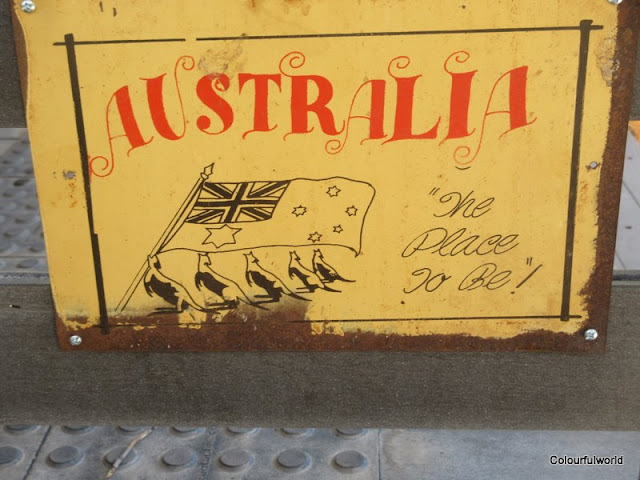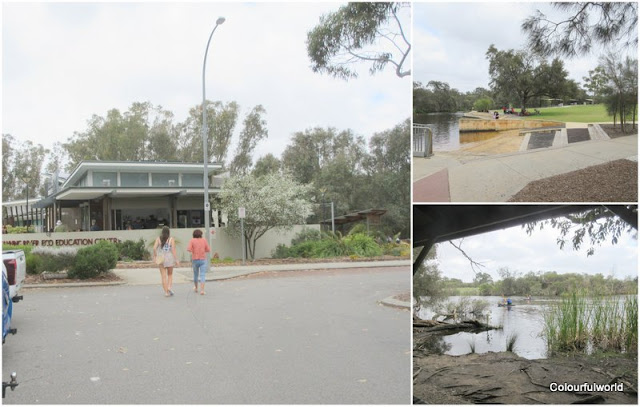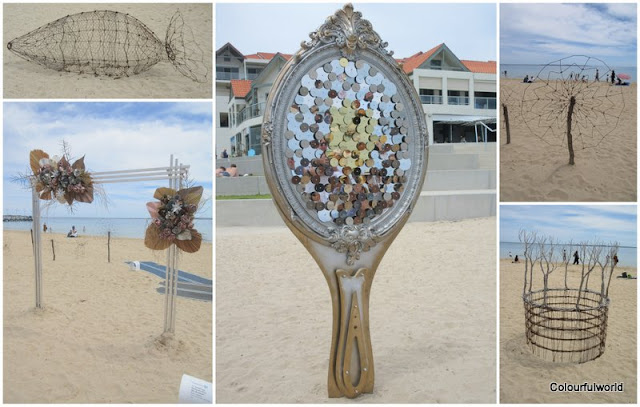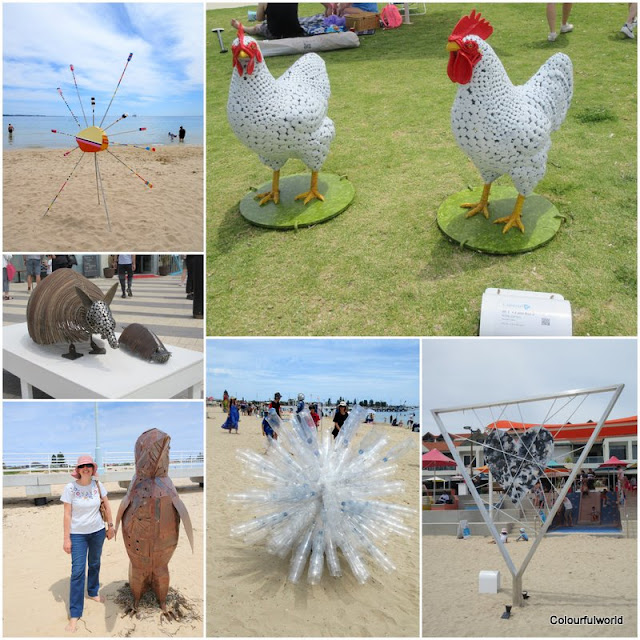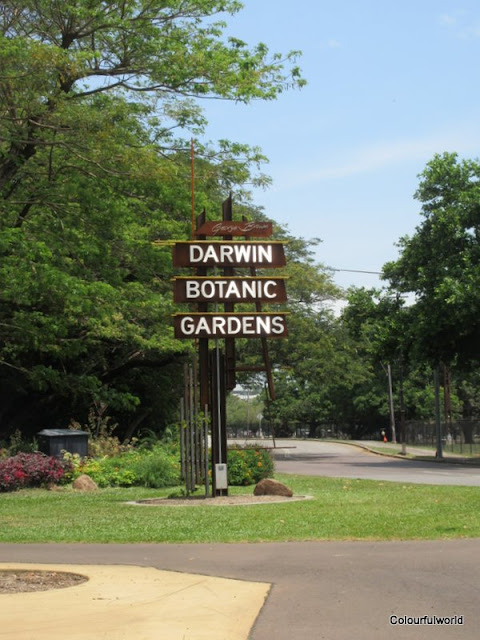Friday 24th September 2021 -
After a continental breakfast at the Knotts Crossing Resort in Katherine, we checked-out, loaded our bags into the tour van, and at 7am were ready to drive the 37km (23mi) to Katherine Gorge in the Nitmiluk (Cicada Place) National Park.

The tour tickets had been pre-purchased, so we just had to wait to be called to board one of the boats at the jetty for the 2 hour tour. In the meantime we noticed the trees above the ticket area were full of scary (to me) bats.

The flat-bottomed boats are able to navigate the shallow waters in the dry season, but sometimes the boat had to slow down to avoid underwater rocky areas.

The guide told us stories about the local Aboriginal people - the Jawoyn - pointed out a few birds, the small sandy beaches, talked about films that were shot in the area, etc.
 |
A lot of swallow nests in this cave, but they were too quick, so didn't capture any with my small camera
|
 |
| Small sandy beaches |
During the dry season it is safe to swim and canoe (which you can hire), there are freshwater crocodiles in the area, but these are harmless if you don't disturb them. Saltwater crocodiles will get into the area during the rainy season, but we were shown a lot of traps along the way and they are removed from the area before the dry season.


There are 100km (62mi) of walking trails, which are best explored during the cooler early morning.
We cruised until a certain point, then disembarked, had a look at Aboriginal rock art, walked a few metres and got back onto another boat the other side of the rocky area to sail into the second gorge.



On our return to the base, from the tour boat the Baruwai lookout was pointed to us. Apparently the most popular lookout at the western end of the gorge, with extensive views over the park and with the best views at sunset, and the trail to get there is only around 1,8km (1.12mi) return.

When we finished, we had a toilet visit, top up our water bottles and back to the bus on our way to Darwin.
About 1,30h later, we stopped for lunch at Pine Creek, the old mining town we had visited the previous day, on our way to Katherine. It's the fourth larges town in the Northern Territory, with a population of about 328 people, which gives you an idea of the population density in this State.
At the pub I ordered Fish and Chips for me, which I could hardly finish as it was a huge serving, but was delicious.
 |
Toilet signs at the Pine Creek Pub
|
 |
The "snake charmer", a snake in water, a bike full of signs and my lunch of Fish and Chips
|
On our return to the van, someone pointed to an elderly local who was holding a snake, can't remember what is was, but not dangerous. He offered if I wanted to hold it, but I'm petrified of snakes, whether good or bad. A few more snakes were in cages on the side of the pub, one might have been hot as she was inside water.
Just over one hour later we reached Adelaide River Cemetery. Situated 116km south of Darwin, and 100mt from the Adelaide River it is a beautifully laid out cemetery with manicured gardens, tropical flowers...
 |
The entrance to the Cemetery
|


Established in 1942, it is the last resting place for service men and women who lost their lives in Northern Australia as a result of WWII.
Divided into two sections - the eastern section if the military cemetery with 434 graves and memorials to persons who died but whose bodies were not recovered and the western section contains burial places of 64 civilians, including a memorial to 9 people killed in the Darwin Post Office, during the first Japanese raid to Darwin on 19th February 1942.

When we were there "Pat Cullinan and his 4x4 adventures" (Australian TV show) team was there filming, so who knows I might be a tv star by now 😏

Next a pit stop at the nearby Adelaide River Inn. I loved the sign "Sorry, we do not have wi-fi. Talk to each other (like it's 1990).

At the entrance to the pub there is a gigantic saltwater crocodile in a glass case.
Inside, on top of the counter is "Charlie", the now embalmed water buffalo that featured in the first Crocodile Dundee movie in 1986.

The movie was inspired by the "real Crocodile Dundee" - the strong and brave Rod Ansell. In August 1999, more than a decade after the movie, from which he didn't profit at all, Rod who was 44 was shot dead by police after an amphetamine induced rampage, that saw him wound 3 men and kill a 33 year old policeman - Glen Huitson.
Glen Huitson was the Officer in Charge of the Adelaide River Police Station and the town has a park named in his honour. There is a statue to the Officer in Livingstone, 60km up the road, where the shooting happened.
Back on the bus, we made our way to Darwin arriving about 1,15h later.

We checked back into the same hotel - Oaks Darwin Elan Hotel, and Jenny and I were even given the same room. As we were waiting in line to check-in I looked behind me and saw the journalist husband of one of my work colleagues also waiting to check-in. Imagine being about 4000km away from home and coming across someone you know!
 |
Oaks Elan Darwin Hotel and hotel room
|
It was our last night in Darwin and after getting ready, we walked a couple of blocks to best tapas restaurant in Darwin- Moorish Cafe.
Once again we were surprised at the high quality of restaurants, the fresh food and great service in Darwin.

Saturday 25th September -
After breakfast, we said our goodbyes, and I checked out and left my suitcase at reception. My two travelling companions would be leaving soon to the airport, but I had a late afternoon flight, so had plenty of time to do some sightseeing around Darwin.
I ordered an Uber to take me to the Museum and Art Gallery of the Northern Territory.
 |
The Museum and sign at the entrance
|
The entry-free museum is a must to visit, with interesting exhibitions about Darwin and Northern Territory's history and how the settlers lived when they first arrived in the area.

The star of the Museum is "Sweetheart" a 50 year old, 5,1mt male crocodile, which weighed 780kg when caught in 1979, and drowned while being caught, probably due to the muscle relaxant used.

Another interesting exhibit is the display on Cyclone Tracy that devastated Darwin on Christmas Eve 1974, with footage and reports about the event and what it has taken to rebuild Darwin into the modern city it is today.
There is a sound booth where you can hear a recording of what the cyclone sounded like as it ripped through the city, killing 71 people, destroying 80% of the houses, and leaving more than 25 thousand out of the 47000 residents homeless.

 |
Cyclone Tracy newspaper photos
|
There is a pavilion housing boats, pearl luggers and historic craft from the Pacific area, and an Indigenous art gallery with works from artist from the Top End.
 |
| Various boats |
 |
The Indigenous Art Gallery
|
The museum is situated right next to the beach at Fannie Bay, but no swimming in Darwin beaches, unless you wish to be eaten by a croc or stung by a deadly jellyfish!
 |
Fannie Bay Beach - right by the Museum
|
Another Uber was called to take me to the George Brown Botanic Gardens 2km away...I would have walked if I had the time, but it was also getting hot.
I picked up a map from the information centre, but kept getting lost!
The 42 hectares gardens were a tropical paradise with many unusual plants I had never come across, divided into many different "garden rooms" - cycad garden, frangipani garden, food garden, African garden, shade garden, and lots of statues - crocodile, dinosaurs...
 |
Dinosaurs in the Botanic Gardens
|
 |
| A metal crocodile statue with fish in his mouth |
During Cyclone Tracy, 89% of the plants were lost. George Brown, who had worked in the gardens since 1969, took charge of the restoration from 1971 to 1990 and the gardens were named after him.
All over the park were Orange Footed Scrubfowl, throwing up soil, not sure if they were making nests...
 |
|




 |
| The beach |
When I left the garden I ordered an Uber to take me to the Esplanade (seaside), took photos of the beach, bought some Sushi for lunch and sat down in a park enjoying some sun while eating. |
Flowers in a park near the seaside
|
Then I walked a few blocks up to the hotel, finding mural after mural... I was in mural heaven 😉, retrieved my bag from the hotel reception, and called another Uber to take me to the airport.
The Qantas flight departed at 4,30pm and I landed in Perth about 3 hours later at 7pm (we are 1 1/2h behind Darwin).
Unlike the flight to Darwin that was half empty and I had 3 seats to myself, this flight was almost full, and the 2 seats next to me were occupied.
And that is the end of my Northern Teritory adventure! Hope you enjoyed the virtual trip and didn't get bored by the dozens of photos...
* * * * * * * * *
The best time to visit Darwin, Katherine and Kakadu National Park would be in the dry season, from May to October, the cooler months. The area has two seasons: hot/wet and hot/dry.
Darwin, is the capital and the largest city of the Northern Territory. Its population is around 150,000 and while the Northern Territory about twice the size France, Spain and Italy combined, or the State of Texas, the total population of the NT is only about 250,000 people. The CBD (central business district) or city centre is small and easily walked. Lots of murals can be found in this area.
I was pleasantly surprised with the city of Darwin and surrounding national parks - a modern city, helpful people, great restaurants, lots of cultural places, diverse markets (which I didn't get a chance to visit), incredible landscapes and abundant wildlife... Even though the beaches are beautiful, they are empty, and you shouldn’t swim at the beaches - jellyfish and saltwater crocodiles await you... and most swimming holes are either closed or not safe to swim in during the rainy season (except in Litchfield National Park, where they remain accessible year round).
Map of our itinerary from Katherine to Darwin:
We covered about 376 Km (234 miles) from 7am to about 5.30pm.


